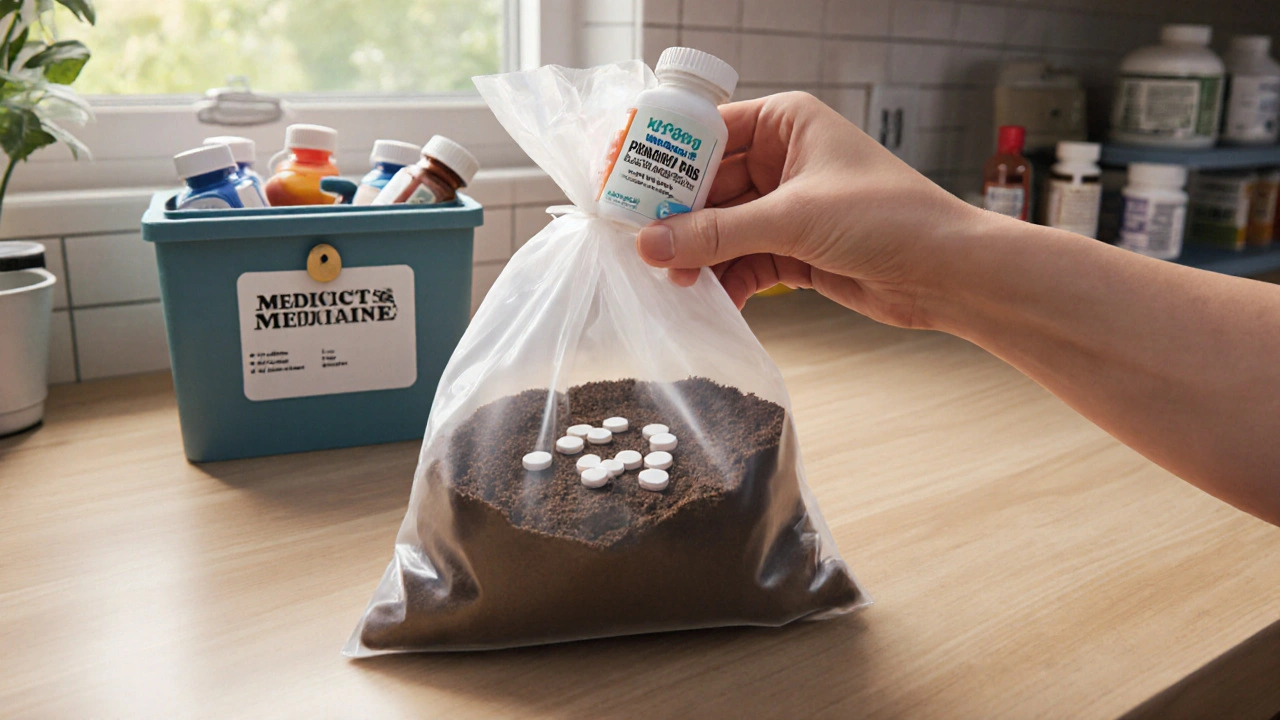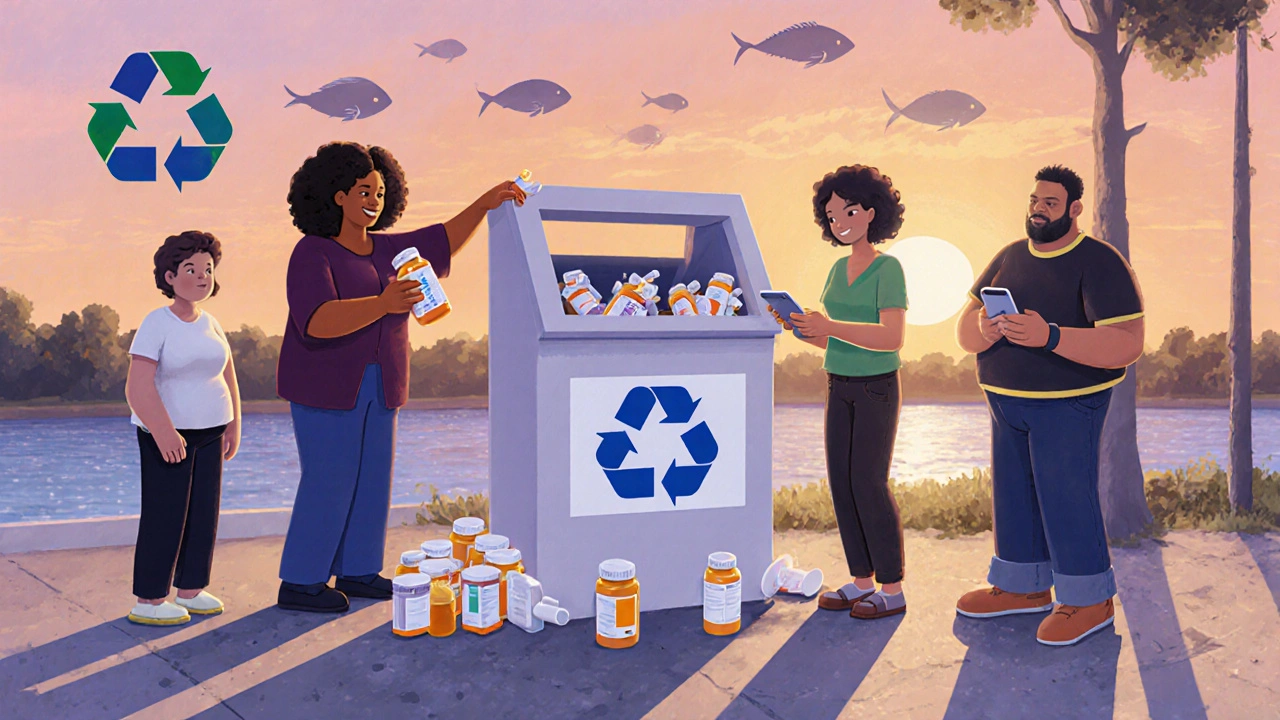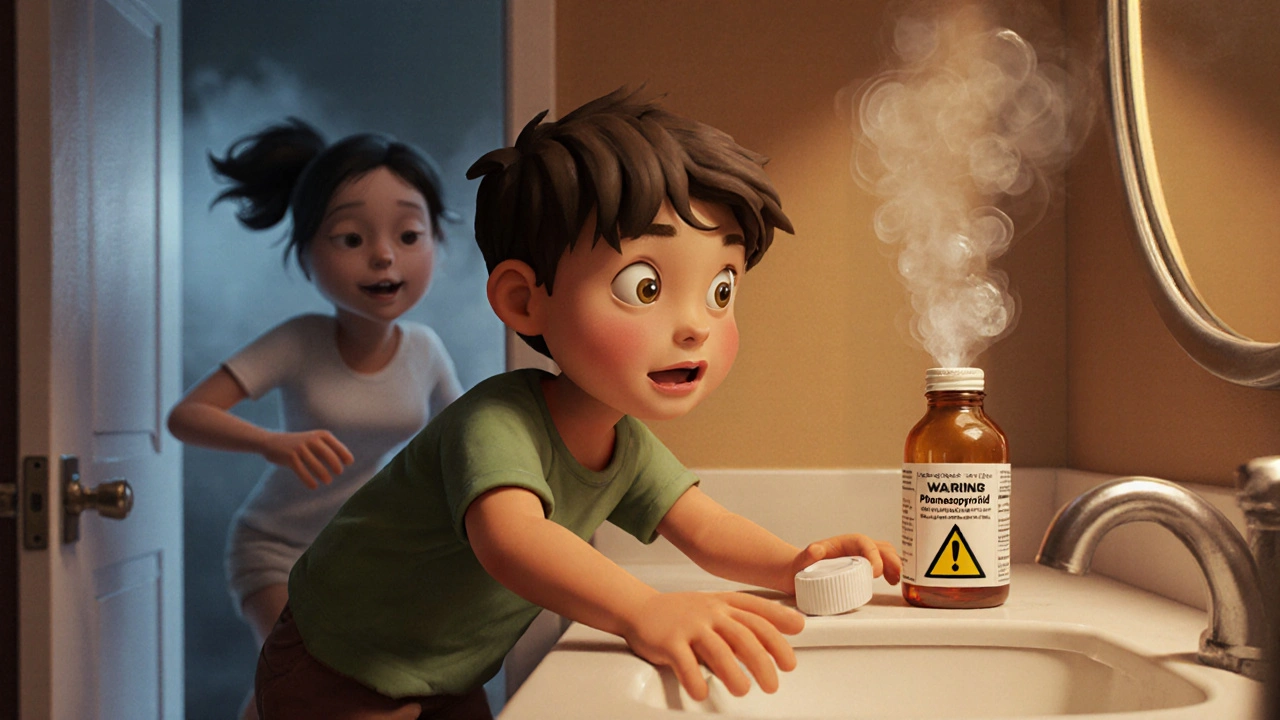Phenazopyridine is a medication you might get for a urinary tract infection (UTI) to ease burning, pain, and urgency. It doesn’t cure the infection-that’s what antibiotics are for-but it helps you feel better while your body fights it off. You’ll likely see it sold under brand names like Azo Standard or Pyridium. But here’s the thing: if you don’t store or dispose of it right, you’re risking harm to yourself, kids, pets, or the environment.
Why Storage Matters More Than You Think
Phenazopyridine isn’t a controlled substance, but that doesn’t mean it’s harmless if misused. Left within reach of children or pets, it can cause serious side effects like vomiting, dizziness, or even blue-tinged skin from methemoglobinemia. Even adults who accidentally take extra doses can end up in the ER.
Keep your phenazopyridine in its original bottle. The label has your name, dosage instructions, and expiration date-critical info if someone else finds it or if you need to show it to a doctor. Store it in a cool, dry place. That means not the bathroom cabinet, where steam and moisture can break it down. A bedroom drawer, a kitchen cabinet away from the sink, or a high shelf in a closet works best.
Lock it up if you have kids, teens, or visitors who might be tempted to try it. A locked medicine box or cabinet is a simple step that prevents accidents. The CDC reports that over 60,000 children under 6 are treated in U.S. emergency rooms each year for accidental medicine poisoning. Most of those cases involve medications left in plain sight.
What to Do With Leftover Pills
You might finish your antibiotic and no longer need phenazopyridine. Maybe you didn’t take all the pills because your symptoms improved. Don’t keep them. Don’t flush them. Don’t toss them in the trash without taking precautions.
The safest way to dispose of phenazopyridine is through a drug take-back program. Many pharmacies, hospitals, and police stations have drop-off boxes. The U.S. Drug Enforcement Administration (DEA) holds National Prescription Drug Take Back Days twice a year, and many local pharmacies participate year-round. Check with your local pharmacy-most now offer free disposal bins.
If no take-back option is nearby, here’s what to do:
- Take the pills out of the bottle.
- Mix them with something unappetizing-used coffee grounds, cat litter, or dirt.
- Put the mixture in a sealed plastic bag or container.
- Throw it in your household trash.
This makes the medication unappealing and unusable. It also prevents someone from digging through your trash and swallowing the pills. Never crush pills or dissolve them in water unless instructed by a pharmacist-some medications can become dangerous if altered.
Why Flushing Is a Bad Idea
You’ve probably heard that flushing meds down the toilet is okay. That’s outdated advice. The EPA and FDA no longer recommend it unless the label specifically says to. Most wastewater systems aren’t designed to filter out pharmaceuticals. Phenazopyridine and other drugs end up in rivers, lakes, and even drinking water supplies. Studies have found trace amounts of medications in water sources across the U.S., affecting fish and aquatic life.
Even if you think one pill won’t matter, it adds up. Millions of people flush meds every year. That’s millions of pills entering the environment. The best practice? Keep it out of the water system entirely.

What About Empty Bottles?
Once you’ve removed the pills and disposed of them properly, you can recycle the bottle. Remove or black out your name and prescription info with a permanent marker. That protects your privacy. Most plastic prescription bottles are made from HDPE (plastic #2), which many curbside recycling programs accept. Check your local recycling rules-some areas require you to remove the cap, others don’t.
If your town doesn’t recycle pill bottles, you can drop them off at pharmacies that participate in recycling programs. CVS, Walgreens, and some independent pharmacies collect empty bottles for proper recycling.
Red Flags: When to Call a Doctor
If you or someone else accidentally takes too much phenazopyridine, call Poison Control at 1-800-222-1222 or go to the ER. Symptoms of overdose include:
- Blue or gray skin color (especially lips or fingernails)
- Difficulty breathing
- Fast heartbeat
- Confusion or dizziness
- Nausea or vomiting
Phenazopyridine can turn your urine orange or red. That’s normal. But if your skin turns that color, it’s not. That’s a sign your body can’t process the drug properly. Don’t wait-get help right away.

What You Should Never Do
Here’s a quick list of mistakes people make:
- Leaving pills on the counter or in the bathroom
- Sharing your prescription with someone else
- Keeping expired meds “just in case”
- Using old bottles to store other pills
- Flushing or pouring pills down the drain
Each of these actions increases risk. Sharing meds is illegal and dangerous-what works for you might harm someone else. Expired phenazopyridine may not work as intended and could break down into harmful compounds. And reusing bottles? That’s a recipe for mix-ups. One woman in Oregon accidentally took her husband’s blood pressure pill because she reused his bottle. She ended up in the hospital.
Make a Habit: Check Your Medicine Cabinet
Once a year, do a quick medicine cabinet clean-out. Look for:
- Expired medications
- Unused prescriptions
- Old OTC drugs you forgot you had
- Pills in unlabeled containers
Get rid of them safely. It’s not just about your health-it’s about protecting your family, your neighbors, and the planet. You don’t need to be a pharmacist to do this right. Just follow the steps: store safely, dispose properly, never share.
What Else Should You Know?
Phenazopyridine only lasts about 24 hours in your system. It’s not addictive, but it can mask symptoms of a worsening UTI. If your pain doesn’t improve after two days, or if you develop a fever, back pain, or chills, you might have a kidney infection. That’s serious. Call your doctor.
Also, don’t take phenazopyridine if you have kidney disease or are allergic to it. It can cause liver damage in rare cases. Always tell your doctor about other meds you’re taking-especially if you’re on sulfa drugs or have glucose-6-phosphate dehydrogenase deficiency (G6PD). These interactions can be dangerous.
Bottom line: Phenazopyridine is a helpful tool, but only if you treat it with care. Store it like you would a sharp tool. Dispose of it like you would hazardous waste. Because even though it’s a small pill, the consequences of misuse are real.
Can I store phenazopyridine in the refrigerator?
No, you shouldn’t store phenazopyridine in the fridge unless the label says to. Most medications, including phenazopyridine, are best kept at room temperature. Moisture from the fridge can cause the pills to break down faster. A cool, dry drawer or cabinet is ideal.
What if I can’t find a drug take-back location near me?
If there’s no take-back site nearby, mix the pills with used coffee grounds, cat litter, or dirt, put them in a sealed plastic bag, and throw them in your household trash. Don’t crush them or dissolve them. This makes them unappealing and unusable, reducing the risk of accidental ingestion or misuse.
Is it safe to flush phenazopyridine down the toilet?
No, flushing phenazopyridine is not safe. The FDA only recommends flushing for a very small list of highly dangerous drugs. Phenazopyridine is not on that list. Flushing contributes to water pollution and can harm aquatic life. Always use a take-back program or the trash disposal method instead.
Can I give my leftover phenazopyridine to a friend with a UTI?
Never give your prescription to someone else. Phenazopyridine doesn’t treat the infection-it only masks symptoms. Your friend might have a different condition, an allergy, or a health issue like kidney disease that makes it dangerous for them. It’s also illegal. Always consult a doctor for proper treatment.
How long does phenazopyridine stay in my system?
Phenazopyridine typically clears from your body within 24 hours. But its effects on urine color can last longer. If you’re still seeing orange or red urine after two days of stopping the drug, talk to your doctor. It could signal a problem with your kidneys or liver.


Jennifer Bedrosian
November 4, 2025 AT 20:01Okay but like why is this even a thing?? I took phenazopyridine last year and my pee looked like a highlighter exploded in my toilet and I thought I was dying. Like I called my mom screaming and she just laughed and said 'honey that's normal' and I cried harder. Why does no one warn you about this??
Lashonda Rene
November 6, 2025 AT 05:59im so glad someone finally wrote this because i had a bottle of this sitting in my bathroom for like 3 years after my last uti and i just kept thinking 'oh i might need it again' but then i read this and realized how dumb that was like i could’ve poisoned my nephew or my cat or even just made the whole house smell like chemical soup. now i keep all meds in a locked drawer and i throw them away the second i dont need them. its crazy how easy it is to forget about pills until its too late.
Andy Slack
November 6, 2025 AT 19:50This is so important. Seriously. I work in a pharmacy and people still ask if they can flush it. I have to explain it every single time. And the worst part? They act like we’re being dramatic. But the water system? It’s not a magic trash chute. It’s a lifeline for fish, frogs, and the people downstream. Just don’t.
Rashmi Mohapatra
November 7, 2025 AT 00:34u guys are so american with ur lock boxes and take back days... in india we just throw old meds in the dustbin and move on. no one cares. and honestly? the environment is already dead. why stress over one pill?
Kelsey Veg
November 7, 2025 AT 11:13Let me break this down for you because you clearly didn’t read the FDA guidelines. Flushing is only acceptable for Schedule II opioids and a handful of other narcotics. Phenazopyridine is NOT on that list. So if you’re flushing it, you’re not just irresponsible-you’re violating federal policy. And no, 'but my neighbor does it' is not a defense. This isn’t TikTok, it’s environmental law.
Alex Harrison
November 8, 2025 AT 08:40thanks for this i just threw out my old bottle today after reading this. i had no idea about the coffee grounds trick. i was gonna just toss the bottle in the recycling but now i know to mark out my name first. also i never knew the orange pee was normal i thought i was leaking blood lol
Jay Wallace
November 8, 2025 AT 10:19Alyssa Fisher
November 10, 2025 AT 00:47It’s fascinating how a small molecule like phenazopyridine can carry so much cultural weight-personal safety, environmental ethics, medical responsibility, even privacy. We treat it like a disposable object, but it’s a pharmacological agent with systemic consequences. The fact that we’ve normalized keeping expired meds in drawers says more about our relationship with medicine than we want to admit. Maybe the real problem isn’t disposal-it’s our refusal to accept impermanence in healthcare.
Alyssa Salazar
November 10, 2025 AT 07:30Wait-so you’re telling me phenazopyridine is a urinary analgesic with no antimicrobial properties? That’s not even pharmacologically sound. You’re just numbing the pain while the infection progresses to pyelonephritis. And people think it’s 'safe' because it’s OTC? That’s like putting a bandage on a severed artery. If your UTI doesn’t resolve in 48 hours with antibiotics, you’re already at risk for sepsis. Stop glorifying symptom masking as 'self-care.' This is triage-level ignorance.
Beth Banham
November 11, 2025 AT 19:06Just wanted to say thanks for posting this. I’ve been meaning to clean out my medicine cabinet for months. Now I have a reason to do it. And I’ll actually follow the steps-coffee grounds, sealed bag, trash. No more flushing. I feel like I’m doing my part, even if it’s small.